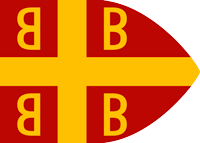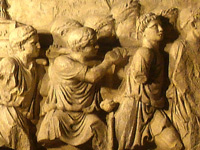Vandalic War (533-534 AD)

The Vandalic War was a conflict fought in North Africa (largely in modern Tunisia) between the forces of the Eastern Roman ( Byzantine The Byzantine Empire, also referred to as the Eastern Roman Empire or Byzantium, was the continuation of the Roman Empire primarily in its eastern provinces during Late Antiquity and the Middle Ages, when its capital city was Constantinople. It survived the fragmentation and fall of the Western Roman Empire in the 5th century AD and continued to exist for an additional thousand years until the fall of Constantinople to the Ottoman Empire in 1453. ) Empire and the Vandalic Kingdom of Carthage, in 533–534. It was the first of Justinian I's wars of reconquest of the lost Western Roman Empire.
The Byzantine Empire, also referred to as the Eastern Roman Empire or Byzantium, was the continuation of the Roman Empire primarily in its eastern provinces during Late Antiquity and the Middle Ages, when its capital city was Constantinople. It survived the fragmentation and fall of the Western Roman Empire in the 5th century AD and continued to exist for an additional thousand years until the fall of Constantinople to the Ottoman Empire in 1453. ) Empire and the Vandalic Kingdom of Carthage, in 533–534. It was the first of Justinian I's wars of reconquest of the lost Western Roman Empire.
The Vandals had occupied Roman North Africa in the early 5th century, and established an independent kingdom there. Under their first king, Geiseric, the formidable Vandal navy carried out pirate attacks across the Mediterranean, sacked Rome and defeated a massive Roman invasion in 468. After Geiseric's death, relations with the surviving Eastern Roman Empire normalized, although tensions flared up occasionally due to the Vandals' militant adherence to Arianism and their persecution of the Chalcedonian native population. In 530, a palace coup in Carthage overthrew the pro-Roman Hilderic and replaced him with his cousin Gelimer. The Eastern Roman emperor Justinian took this as a pretext to interfere in Vandal affairs, and after he secured his eastern frontier with Sassanid Persia in 532, he began preparing an expedition under general Belisarius, whose secretary Procopius wrote the main historical narrative of the war. Justinian took advantage of, or even instigated, rebellions in the remote Vandal provinces of Sardinia and Tripolitania. These not only distracted Gelimer from the Emperor's preparations, but also weakened Vandal defences through the dispatch of the bulk of the Vandal navy and a large portion of their army under Gelimer's brother Tzazon to Sardinia.
The Roman expeditionary force set sail from Constantinople in late June 533, and after a sea voyage along the coasts of Greece and southern Italy, landed on the African coast at Caputvada in early September, to Gelimer's complete surprise. The Vandal king gathered his forces and met the Roman army at the Battle of Ad Decimum, near Carthage, on 13 September. Gelimer's elaborate plan to encircle and destroy the Roman army came close to success, but Belisarius was able to drive the Vandal army to flight and occupy Carthage. Gelimer withdrew to Bulla Regia, where he gathered his remaining strength, including the army of Tzazon, which returned from Sardinia. In December, Gelimer advanced towards Carthage and met the Romans at the Battle of Tricamarum. The battle resulted in a Roman victory and the death of Tzazon. Gelimer fled to a remote mountain fortress, where he was blockaded until he surrendered in the spring.
Belisarius returned to Constantinople with the Vandals' royal treasure and the captive Gelimer to enjoy a triumph, while Africa was formally restored to imperial rule as the praetorian prefecture of Africa. Imperial control scarcely reached beyond the old Vandal kingdom, however, and the Moorish tribes of the interior proved unwilling to accept imperial rule and soon rose up in rebellion. The new province was shaken by the wars with the Moors and military rebellions, and it was not until 548 that peace was restored and Roman government firmly established.
HISTORY

RESOURCES
This article uses material from the Wikipedia article "Vandalic War (533-534 AD)", which is released under the Creative Commons Attribution-Share-Alike License 3.0.
© Stories Preschool. All Rights Reserved.










